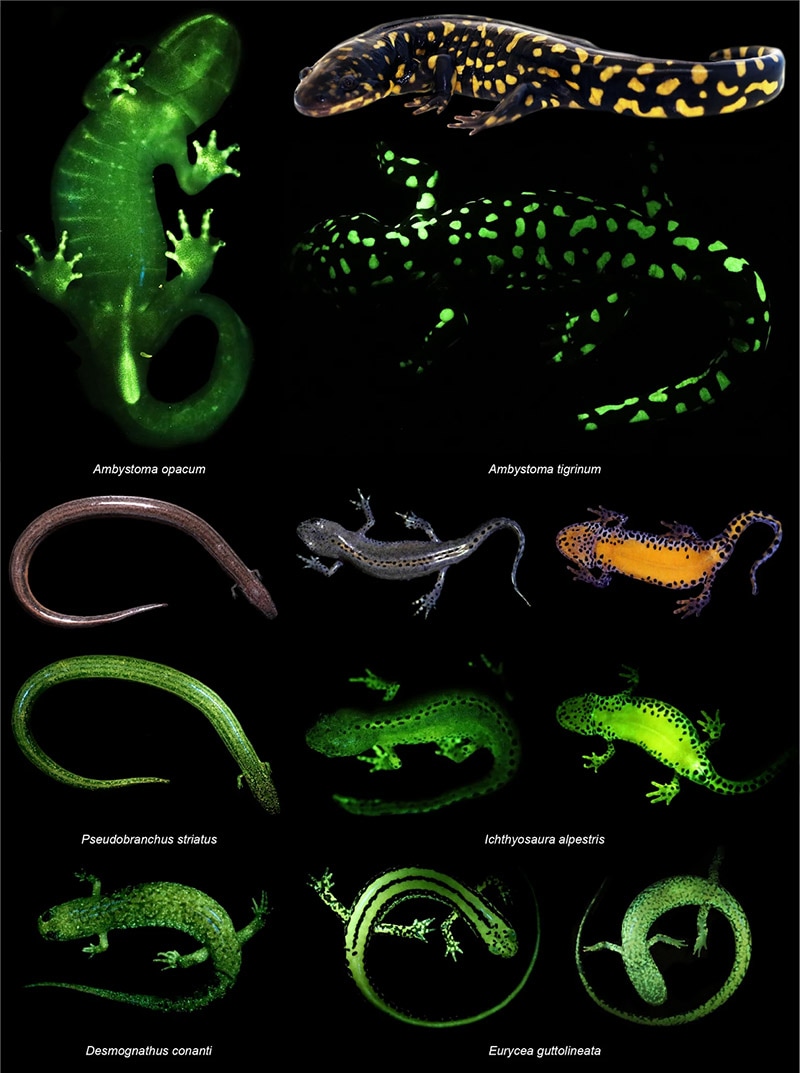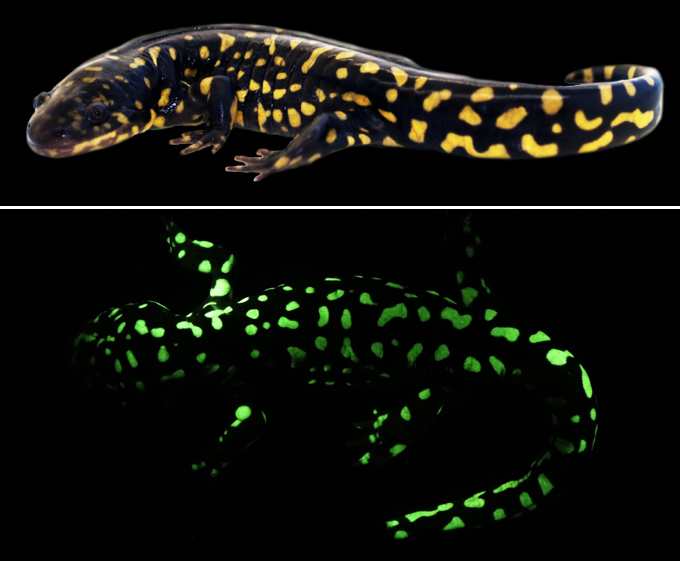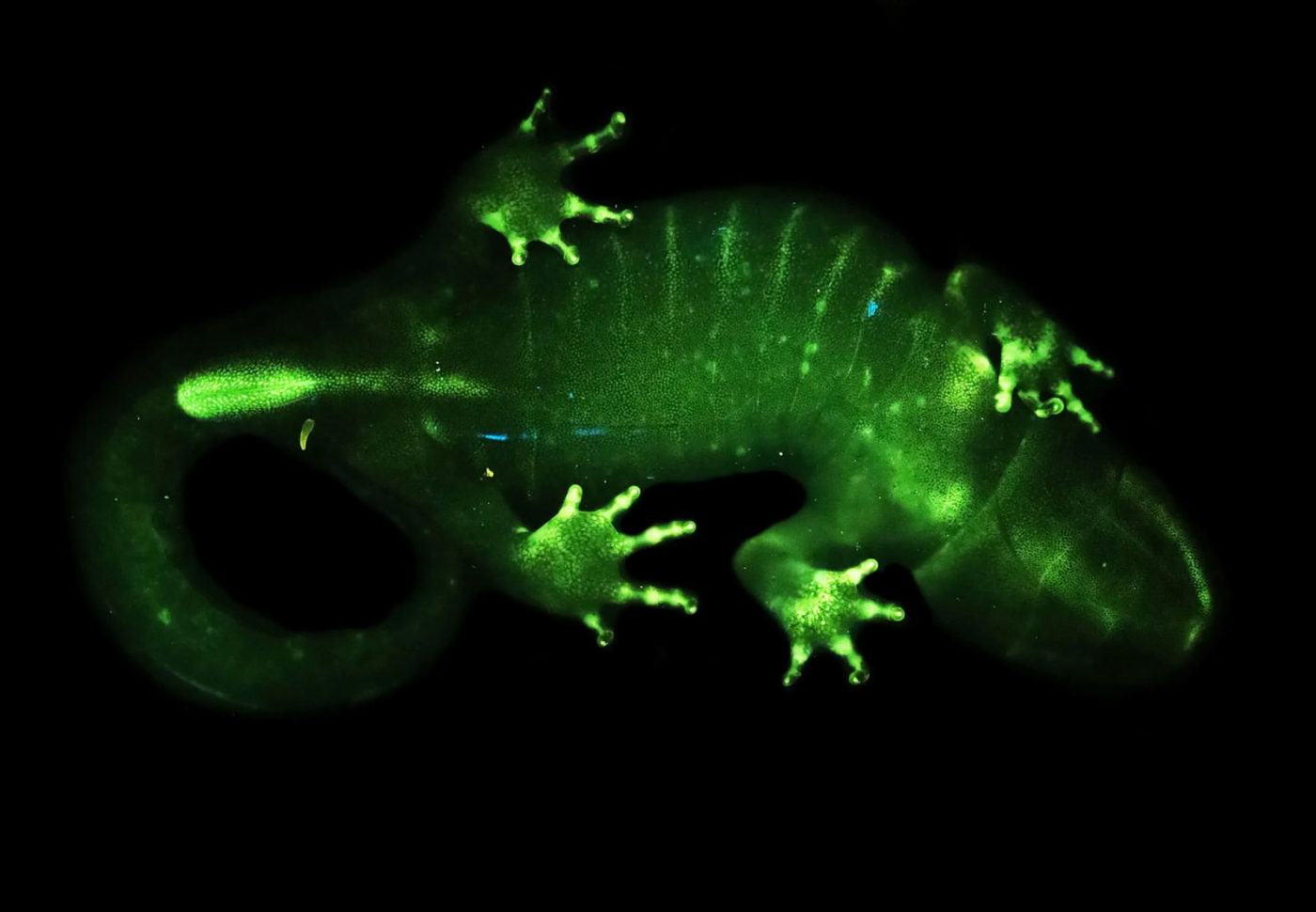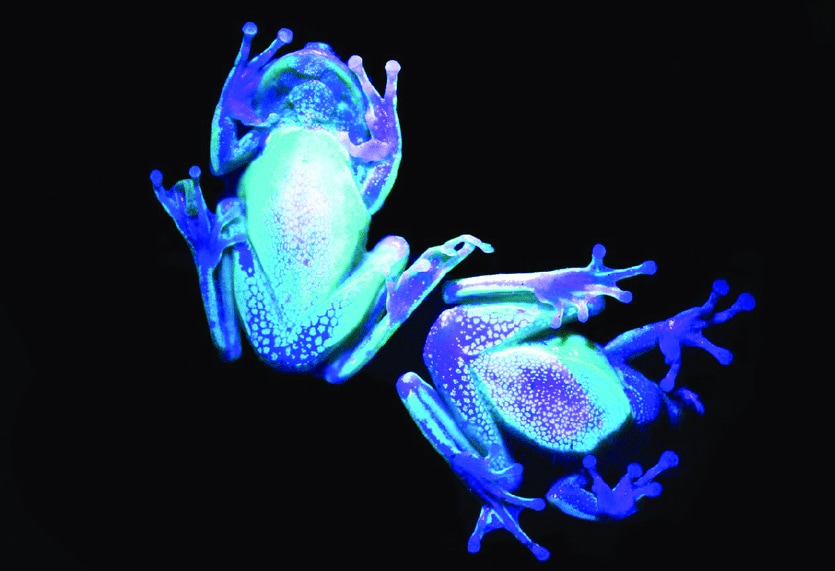Have you already read the Cool Frog Facts article and Why Frogs Are Important? Even before I learned that amphibians can also glow in the dark, frogs were already the shining stars of my world! Here, I’d like to share with you how widespread biofluorescence was discovered in amphibians, exactly what that means, and how that capability can be useful to those animals, as well as to us.
In the image above, Cranwell’s Horned Frog (Ceratophrys cranwelli) glows green under excitation light. Photo by Jennifer Y. Lamb and Matthew P. Davis, from Salamanders and other amphibians are aglow with biofluorescence.
How biofluorescence was discovered in amphibians
Once upon a time (or more specifically in 2020) there were two researchers based at St. Cloud State University, in Minnesota, who asked themselves whether amphibians might commonly glow under certain types of light. The first was Dr. Jennfier Lamb, a herpetologist who studies the behavior, life history and other biological aspects of amphibians and reptiles. The second was Dr. Matthew P. Davis, who studies deep-sea fishes, and how they’ve evolved traits, such as bioluminescence, to help them live in the dark. At the time of their discovery, biofluorescence had already been observed in other, generally aquatic animals, but little exploration on the topic had been done on amphibians. So, when they decided to investigate the commonality of biofluorescence in that group, they were aghast to find out how widespread it was! At first, they focused on adult salamanders, but as they excitingly examined other groups and life stages of amphibians, they found that all of them biofluoresced!
To be clear, this doesn’t mean that you’ll be able to witness frogs glowing softly in the moonlight as you walk past their breeding pond late one night, because you need special lighting and equipment to observe the phenomenon. Lucky for frog and amphibian lovers everywhere, Lamb and Davis not only had the right equipment to detect biofluorescence, but they also the idea and know-how to look for it!

Varying patterns of biofluorescence observed across salamanders. Image by Jennifer Y. Lamb and Matthew P. Davis, in Salamanders and other amphibians are aglow with biofluorescence.
Biofluorescence is the re-radiation of light at a different wavelength
Biofluoresence is not the same as bioluminescence, which is when living organisms actually produce and emit light themselves, either through some sort of internal chemical reaction, or more rarely, when bacterial symbionts do it for them. Angler fish, jellyfish, fireflies and some mushrooms are perhaps some of the creatures that you’ve heard can do this.
Biofluorescence occurs when living organisms absorb waves of high energy light, for instance in the blue or ultraviolet range, and then radiate it back at lower wavelengths, usually in the ranges of red, orange or green. To better visualize the difference, imagine the light that a glow stick emits when you crack it to spark a chemical reaction inside (luminescence), compared to the bright blue-purple glow that radiates from your white t-shirt when you’re happily dancing under an ultraviolet light (fluorescence).
To reveal the biofluorescent capabilities of amphibians, Lamb and Davis shined blue and ultraviolet light-emitting flashlights on the animals, while using special filters to block out all but the fluorescent light that the animals radiated. Particularly under blue light, all of the amphibians they examined emitted various patterns of green to yellow light of different intensities. In many cases, the fluorscent light came from bright and bold spots and stripes that were already visible to us under full spectrum light; in other cases, the bellies shined bright while the backs remained dark; and in still other cases, it was mainly the cloacal region that blazed, as if to garner the sexual attention of any potential mate. Even species that appeared dull under full spectrum light gave off some kind of fluorescent shine. Overall, the tissue or substance that gave rise to a glow under excitation light varied from skin, to bone, to mucus-like skin secretions, to urine.
As such, the structural or chemical mechanisms causing the phenomenon remain unknown, sparking a need for further research. Regardless, the presence of biofluorescence in the wide array of animals that they examined suggests that the trait evolved early on within the ancestry of modern-day amphibians.

An eastern tiger salamander’s (Ambystoma tigrinum) yellow spots give off a green glow under blue light. Photo by Jennifer Y. Lamb and Matthew P. Davis from Salamanders and other amphibians are aglow with biofluorescence.
Why biofluorescence might be important to amphibians
Lamb and Davis hypothesized that the biofluorescent traits that they observed in amphibians may play key roles in communication and signaling between species or within populations. To verify this, it needs to be determined whether or not amphibian eyes have evolved a structural sensitivity to their own biofluorescence, and whether amphibians are ever exposed to the kinds of ambient light that are conducive to this phenomenon within their natural environments. Other roles that biofluorescence could play in the daily lives of amphibians are those of aposematism (a warning coloration to ward off potential predators), mimicry or even camouflage.

The cloaca of the Marbled Salamander (Ambystoma opacum) might glow brightly to attract the attention of a potential mate. Photo by Jennifer Y. Lamb and Matthew P. Davis, from Figure 1 in Salamanders and other amphibians are aglow with biofluorescence.
Why the biofluorescence of amphibians might be important to humans
So, frogs and other amphibians just became way cooler in my eyes! As Lamb and Davis pointed out, their biofluorescent capabilities ‘‘shine a new light on just how much more we still have to learn about these fascinating vertebrates’’.
Already, researchers are aware that frogs produce dozens of skin secretions that have antibiotic, analgesic and other properties of great pharmaceutical interest, and perhaps hundreds or thousands more of these substances are waiting to be discovered. Recently, frog nest foams have been suggested as natural, stable and biocompatible agents that could serve well as mild topical drug delivery systems for humans.
Now, the biofluorescent proteins and other secretions or tissues of amphibians might have the potential to make new medical history. In 2008, the Nobel Peace Prize for Chemistry was awarded to three researchers who discovered and developed a substance known as the Green Fluorescent Protein (GFP), which was initially isolated from a jellyfish, and is now widely used as a fluorescent marker during research on the cellular and systemic functioning of living organisms.
Might frogs produce or possess a biofluorescent substance that could further advance those medical research techniques? The search is already on for different biofluorescent substances in aquatic organisms that might just do this (watch this NOVA/National Geographic special documentary Creatures of Light). Only time will tell. But it is nevertheless exciting to consider that if excitation light proves useful at detecting small, secretive amphibian species in their environments, biofluorescence may become an inexpensive way for biologists to survey and monitor the biodiversity of these animals, and thereby an important tool for critically-needed amphibian conservation projects worldwide.

UV light was used to conduct a field-based study of tropical tree frogs, including these South American tree frogs (Boana punctata). Photo credit: Jorge Enrique García Melo, in Thompson, M. E., Saporito, R. A., Ruiz-Valderrama, D. H., Medina Rangel, G. F., Donnelly, M. A. (2019). A field-based survey of fluorescence in tropical tree frogs using an LED UV-B flashlight. Herpetology Notes. 12. 987-990



